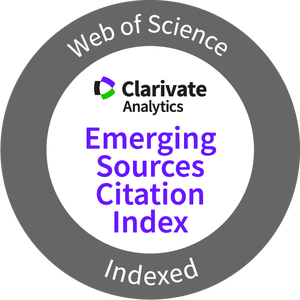¿Es efectivo el patrocinio deportivo? Efectos sobre el valor de marca y el engagement en Twitter
Resumen
El propósito de este estudio fue analizar el impacto del patrocinio deportivo en redes sociales sobre el valor de marca y el compromiso en Twitter. En concreto, se centra en la efectividad de las marcas patrocinadoras del fútbol ecuatoriano en las cuatro dimensiones del valor de marca (reconocimiento, lealtad, calidad percibida y asociación de marca) y en el compromiso del consumidor. Este estudio empírico se llevó a cabo mediante dos encuestas en línea dirigidas a aficionados al fútbol, con dos estímulos diferentes: marca patrocinadora (n=224) frente a marca no patrocinadora (n=260). Los resultados indicaron que la marca patrocinadora presenta un impacto positivo y significativo en su valor de marca y en el compromiso en Twitter en comparación con la marca no patrocinadora. El estudio afirma que el valor de marca y el compromiso del consumidor pueden ofrecer a los académicos y profesionales del sector un método viable para evaluar la efectividad del patrocinio deportivo en redes sociales.
Descargas
-
Resumen547
-
PDF204
Citas
Aaker, D. (1991). Managing Brand Equity: capitalizing on the value of a brand name. The free press. Obtenido de https://www.inovaconsulting.com.br/wp-content/uploads/2016/09/managing-brand-equity-by-david-aaker.pdf
Aaker, D. (1996). Measuring brand equity across products and markets. California Management Review, 38(3), 102–120.
Abeza, G., Pegoraro, A., Naraine, M., B, S., & O’Reilly, N. (2014). Activating a global sport sponsorship with social media: an analysis of TOP sponsors, Twitter, and the 2014 Olympic Games. International Journal of Sport Management and Marketing, 15(3), 184-213.
Abosag, I., Roper, S., & Hind, D. (2012). Examining the relationship between brand emotion and brand extension among supporters of professional football clubs. European Journal of Marketing 46(9), 1233-1251. https://doi.org/10.1108/03090561211247810
Alonso-Dos-Santos, M., Calabuig, F., Rejón, F., & Pérez, C. (2016). Influence of the virtual brand community in sports sponsorship. Psychology & Marketing, 32(12), 1091–1097.
Alonso-Dos-Santos, M., Rejón, F., Pérez, C., Calabuig, F., & Ko, Y. (2018). Engagement in sports virtual brand communities. Journal of Business Research, 89, 273–279.
Anagnostopoulos, C., Parganas, P., Chadwick, S., & Fenton. (2018). A Branding in pictures: using Instagram as a brand management tool in professional team sport organisations. European Sport Management Quarterly, 18(4), 413–438. https://doi.org/10.1080/1
Aragonés, C., Kúster, I., & Vila, N. (2020). Transferencia valor-experiencia a través del patrocinio deportivo: Antecedentes y consecuencias. Revista de Psicología del Deporte, 29, 133–142.
Balliauw, M., Onghena, E., & Mulkens, S. (2020). Identifying factors affecting the value of advertisements on football clubs’ and players’ social media: a discrete choice analysis. International Journal of Sports Marketing and Sponsorship, 22, 652-676.
Bauer, H., Sauer, N., & Exler, S. (2005). The loyalty of German soccer fans: does a team’s brand image matter? International Journal of Sports Marketing and Sponsorship, 7(1), 8–16. https://doi.org/10.1108/ijsms-07-01-2005-b004
Bigné, E., Simonetti, A., Ruiz, C., & Kakaria, S. (2021). How online advertising competes with user-generated content in TripAdvisor. A neuroscientific approach. Journal of Business Research, 123(5), 279-288.
Bigné, J. (1997). The Effectiveness of Sponsorship. Journal of Promotion Management, 4(2), 65-90.
Brodie, R., Hollebeek, L., Jurić, B., & Ilić, A. (2011). Customer engagement: conceptual domain, fundamental propositions, and implications for research. Journal of Service Research, 14(3), 252-271.
Burton, N. (2019). Exploring user sentiment towards sponsorship and ambush marketing. International Journal of Sports Marketing and Sponsorship, 20(4), 583–602. https://doi.org/10.1108/IJSMS-03-2019-0026
Chmait, N., Westerbeek, H., Eime, R., Robertson, S., Sellitto, C., & Reid, M. (2020). Tennis influencers: The player effect on social media engagement and demand for tournament attendance. Telematics and Informatics, 50(1), 1-15.
Cornwell, T., & Kwon, Y. (2020). Sponsorship-linked marketing: Research surpluses and shortages. Journal of the Academy of Marketing Science, 48(4), 607-629.
Deloitte. (1 de abril de 2020). El Impacto ECONÓMICO Del COVID-19: Deloitte España. https://www2.deloitte.com/es/es/pages/about deloitte/articles/impacto-economico-del-covid19.html
Dessart, L., Veloutsou, C., & Morgan, A. (2016). Capturing consumer engagement: duality, dimensionality and measurement. Journal of Marketing Management, 35(6), 399-426.
Do, H., Ko, E., & Woodside, A. (2015). Tiger Woods, Nike, and I are (not) best friends: How brand’s sports sponsorship in social-media impacts brand consumer’s congruity and relationship quality. International Journal of Advertising, 34(4), 658–677.
Donlan, L. (2013). The Role of Brand Knowledge in Determining Sponsorship Effectiveness. Journal of Promotion Management, 19(2), 241–264. https://doi.org/10.1080/10496491.2013.769474
Donlan, L. (2014). An empirical assessment of factors affecting the brand-building effectiveness of sponsorship. Sport, Business and Management: An International Journal, 4(1), 6-25. https://doi.org/10.1108/SBM-09-2011-0075
Evans, A. B., Dolan, P., Fahlén, J., Hoekman, R., Lenneis, V., & Wilcock, L. (2020). Sport in the face of the COVID-19 pandemic: towards an agenda for research in the sociology of sport. European Journal for Sport and Society, 17(2), 85–95. https://doi.org/10.1080/16138171.2020.1765100
Falk, R., & Miller, N. (1992). A primer for soft modeling. Akron, OH: The University of Akron Press.
Fenton, A., Keegan, B., & Parry, K. (2021). Understanding Sporting Social Media Brand Communities, Place and Social Capital: A Netnography of Football Fans. Communication & Sport, 11(1), 1-21. https://doi.org/10.1177/2167479520986149
Górecka, D. (2020). Selecting the right football club to sponsor: Multi-criteria analysis. Journal of Physical Education and Sport, 20(5), 2867–2874. https://doi.org/10.7752/jpes.2020.s5389
Hambrick, M. (2012). Six degrees of information: using social network analysis to explore the spread of information within sport social networks. International Journal of Sport Communication, 5(1), 6–34.
Hambrick, M., & Kang, S. (2014). Pin It: Exploring How Professional Sports Organizations Use Pinterest as a Communications and Relationship-Marketing Tool. Communication & Sport, 3(4), 434-457. https://doi.org/10.1177/2167479513518044
Hazari, S. (2018). Investigating social media consumption, sports enthusiasm, and gender on sponsorship outcomes in the context of Rio Olympics. International Journal of Sports Marketing and Sponsorship, 19(4), 396–414. https://doi.org/10.1108/IJSMS-01-20
Henseler, J., Wilson, B., & Westberg, K. (2011). Managers’ perceptions of the impact of sport sponsorship on brand equity: which aspects of the sponsorship matter most? Sport Marketing Quarterly, 20(1), 7–21.
Hollenbeck, C. R. (2012). Consumers’ use of brands to reflect their actual and ideal selves on Facebook. International Journal of Research in Marketing, 29(4), 395-405. https://doi.org/10.1016/j.ijresmar.2012.06.002
Janoskova, K. &. (2017). Comparison of selected internationally recognized brand valuation methods. Oeconomia Copernicana, 8(1), 99–110.
Keller, K. (1993). Conceptualizing, measuring, and managing customer-based brand equity. Journal of Marketing, 57(1), 1–22.
Kelly, S., Ireland, M., Mangan, J., & Williamson, H. (2016). It works two ways: impacts of sponsorship alliance upon sport and sponsor image. Sport Marketing Quarterly, 26(4), 241–259.
Khan, F., Qamar, U., & Bashir, S. (2016). A decision support framework for enhanced sentiment analysis and polarity classification. Information Sciences, 367, 862–873. https://doi.org/10.1016/j.ins.2016.07.028
Ko, Y., Chang, Y., Park, C., & Herbst, F. (2017). Determinants of consumer attitude toward corporate sponsors: A comparison between a profit and nonprofit sport event sponsorship. Journal of Consumer Behaviour, 16(2), 176–186.
Koronios, K., & Dimitropoulos, P. (2020). Examining Sponsorship's Effectiveness Over the Internet: A Conceptual Framework for Researchers and Practitioners. International Journal of Innovation and Technology Management, 17(4). 1-18. https://doi.org/10.1142/S0219877020500273
López, S., & Anagnostopoulos, C. (2020). COVID-19 and soccer teams on instagram: The case of corporate social responsibility. International Journal of Sport Communication, 13(3), 447–457. https://doi.org/10.1123/ijsc.2020-0230
Maldonado, C., Durán, A., Álvarez, J., & Del Río, M. (2019). Sports sponsorship: scientific coverage in academic journals. Journal of Entrepreneurship and Public Policy, 8(1), 163-186. https://doi.org/10.1108/JEPP-03-2019-106
Martínez, J., & Bigné, E. (2017). The value of marketer- generated content of social network sites: Media antecedents and behavioral responses. Journal of Electronic Commerce Research, 18(1), 52–72.
Mastromartino, B., Ross, W., Wear, H., & Naraine, M. (2020). Thinking outside the ‘box’: A discussion of sports fans, teams, and the environment in the context of COVID-19. Sport in Society, 23(2), 1-17.
Meengaghan, T., Mcloughlin, D., & Mccormack. (2013). (2013). New Challenges in Sponsorship Evaluation Actors, New Media, and the Context of Praxis. Psychology and marketing, 30(5), 444-460. http://doi.org/10.1002/mar.20618
Mehta, M. K. (2021). Customer expectations in the hotel industry during the COVID-19 pandemic: a global perspective using sentiment analysis. Tourism Recreation Research, 48(1), 1-18.
Nogueira, E., & Tsunoda, D. (2018). A proposed model for consumer-based brand equity analysis on social media using data mining and social network analysis. Journal of Relationship Marketing, 17(2), 95-117.
Organización Mundial de la Salud. (2020). Información Básica sobre la Covid-19. Recuperado el 13 de septiembre de 2021, de Organización Mundial de la Salud: https://www.who.int/es/emergencies/diseases/novel-coronavirus-2019/question-and-answers-hub/q-a-detail/coronavirus-disease-covid-19
Pantano, E., Giglio, S., & Dennis, C. (2019). Making sense of consumers’ tweets: Sentiment outcomes for fast fashion retailers through Big Data analytics. International Journal of Retail and Distribution Management, 47(9), 915-927. https://doi.org/10.1108/IJRDM-07-2018-0127
Papadimitriou, D., & Apostolopoulou, A. (2008). Event sponsorship as a value creating strategy for brands. Journal of Product & Brand Management, 17(4), 212–222. https://doi.org/10.1108/10610420810887563
Pappu, R., Quester, P., & Cooksey, R. (2005). Consumer-based brand equity: Improving the measurement-empirical evidence. Journal of Product & Brand Management, 14(3), 143–154.
Prados, M., & Del Barrio, S. (2021). Key antecedents of brand equity in heritage brand extensions: The moderating role of tourist heritage experience. European Research on Management and Business Economics, 27(3), 1-10.
Read, W., Robertson, N., McQuilken, L., & Ferdous, A. (2019). Consumer engagement on Twitter: perceptions of the brand matter. European Journal of Marketing, 53(9), 1905-1933. https://doi.org/10.1108/EJM-10-2017-0772
Read, W., Robertson, N., McQuilken, L., & Ferdous, A. (2019). Consumer engagement on Twitter: Perceptions of the brand matter. European Journal of Marketing, 53(9), 1905–1933. https://doi.org/10.1108/EJM-10-2017-0772
Sanderson, J., & Brown, K. (2020). COVID-19 and youth sports: Psychological, Developmental, and Economic Impacts. International Journal of Sport Communication, 13(3), 313–323. https://doi.org/10.1123/ijsc.2020-0236
Santomier, J. (2008). New media, branding and global sports sponsorship. International Journal of Sports Marketing and Sponsorship, 10(1), 15–28. https://doi.org/10.1108/ijsms-10-01-2008-b005
Schlesinger, W., Cervera, A., & Romero, M. (2020). How does sponsorship of a high-involvement sports event mark the sponsor brand? An application to public institutions. Cuadernos de Gestion, 22(2), 123–148. https://doi.org/10.5295/CDG.191085WS
Sharma, S., Singh, S., Kujur, F., & Das, G. (2021). Social media activities and its influence on customer-brand relationship: An empirical study of apparel retailers’ activity in india. Journal of Theoretical and Applied Electronic Commerce Research, 16(4), 602-617. https://doi.org/10.3390/jtaer16040036
Stojanovic, I., Andreu, L., & Curras, R. (2018). Effects of the intensity of use of social media on brand equity: An empirical study in a tourist destination. European Journal of Management and Business Economics, 27(1), 83-100. https://doi.org/10.1108/EJMBE-11-2017-0049
Sudolska, A., & Łapińska, J. (2020). Implementation of the CSR concept through sport sponsorship: The case of the polish chemical capital group. Journal of Physical Education and Sport, 20(2), 1100–1105. https://doi.org/10.7752/jpes.2020.s2153
Swani, K., Milne, G. R., & Miller, E. (2021). Social media services branding: The use of corporate brand names. Journal of Business Research, 125(3), 785–797. https://doi.org/10.1016/j.jbusres.2019.04.033
Tsordia, C., Papadimitriou, D., & Parganas, P. (2018). The influence of sport sponsorship on brand equity and purchase behavior. Journal of Strategic Marketing, 26(1), 85-105.
Vivek, S., Beatty, S., & Morgan, R. (2012). Customer engagement: exploring customer relationships beyond purchase. Journal of Marketing Theory and Practice, 20(1), 22-146.
Wakefield, L., Wakefield, K., & Keller, K. (2020). Understanding Sponsorship: A Consumer-Centric Model of Sponsorship Effects. Journal of Advertising, 49(3), 320–343. https://doi.org/10.1080/00913367.2020.1751011
Wang, T., Thai, T., Ly, P., & Chi, T. (2021). Turning social endorsement into brand passion. Journal of Business Research, 23, 429–439. https://doi.org/10.1016/j.jbusres.2021.01.011
Weiger, W., Wetzel, H., & Hammerschmidt, M. (2017). Leveraging marketer-generated appeals in online brand communities: An individual user-level analysis. Journal of Service Management, 28(1), 133-156. https://doi.org/10.1108/JOSM-11-2015-0378
Weimar, D., Holthoff, L., & Biscaia, R. (2020). When sponsorship causes anger: understanding negative fan reactions to postings on sports clubs’ online social media channels. European Sport Management Quarterly, 22(3), 335-357. https://doi.org/10.1080/16184742.2020.186593
Woisetschläger, D., Backhaus, C., & Cornwell, T. (2017). Inferring corporate motives: How deal characteristics shape sponsorship perceptions. Journal of Marketing, 81(5), 121–141. https://doi.org/10.1509/jm.16.0082
Yazdanparast, A., & Bayar, O. (2020). Olympic Sponsorships and Brand Value: An Empirical Analysis. Journal of Advertising, 50(4), 1-21. https://doi.org/10.1080/00913367.2020.1856737
Yoo, B., & Donthu, N. (2001). Developing anda validating a multidimensional consumer-based brand equity scale. Journal of Business Research, 52(1), 1-14. https://doi.org/10.1016/S0148-2963(99)00098-3
Yoo, B., Donthu, N., & Lee, S. (2000). An Examination of Selected Marketing Mix Elements and Brand Equity. Journal of the Academy of Marketing Science, 28, 195-211. https://doi.org/10.1177/0092070300282002
Zeithaml, V. (1988). Consumer perceptions of price, quality, and value: a means-end model and synthesis of the evidence. Journal of Marketing, 52(3), 2-22.
Las obras que se publican en esta revista están sujetas a los siguientes términos:
1. El Servicio de Publicaciones de la Universidad de Murcia (la editorial) conserva los derechos patrimoniales (copyright) de las obras publicadas, y favorece y permite la reutilización de las mismas bajo la licencia de uso indicada en el punto 2.
© Servicio de Publicaciones, Universidad de Murcia, 2013
2. Las obras se publican en la edición electrónica de la revista bajo una licencia Creative Commons Reconocimiento-NoComercial-SinObraDerivada 3.0 España (texto legal). Se pueden copiar, usar, difundir, transmitir y exponer públicamente, siempre que: i) se cite la autoría y la fuente original de su publicación (revista, editorial y URL de la obra); ii) no se usen para fines comerciales; iii) se mencione la existencia y especificaciones de esta licencia de uso.
3. Condiciones de auto-archivo. Se permite y se anima a los autores a difundir electrónicamente las versiones pre-print (versión antes de ser evaluada) y/o post-print (versión evaluada y aceptada para su publicación) de sus obras antes de su publicación, ya que favorece su circulación y difusión más temprana y con ello un posible aumento en su citación y alcance entre la comunidad académica.



















